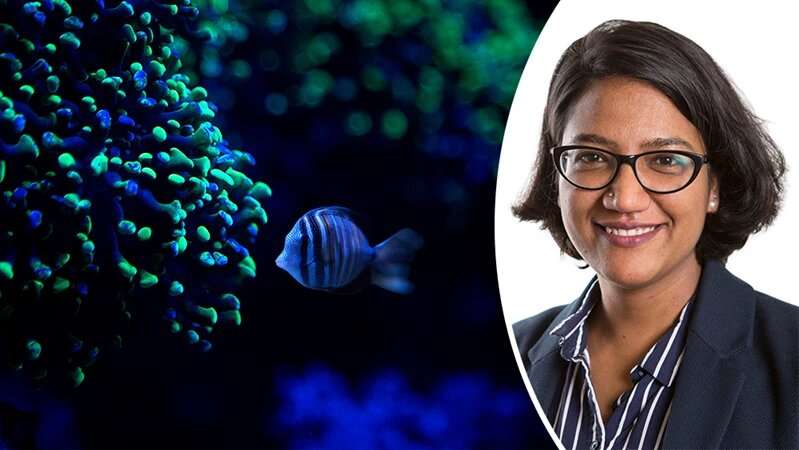Biobased products can produce luminescent textiles

Luminescent textiles can be created by using a bioluminescent reaction system. This is something that Sweta Iyer, with her newly-minted doctorate, has established. Her doctoral thesis in the field of Textile Technology at the University of Borås can now be useful in a number of different areas in society.
A neon-colored fish swims vividly through the sea, lighting up the water. As well as textile technology research. Sweta Iyer's doctoral thesis, "Luminescent textiles usingbiobased products—A bioinspired approach," is based on there being living organisms in nature with properties that humans can benefit from in many ways. One example is precisely how luminescence phenomena in nature, i.e., bodies emitting invisible cold light, can be used to create luminescent textiles.
The journey to this study began when Sweta Iyer, after graduating with a Master's degree in physical chemistry from the University of Mumbai in India, began working as a researcher at several textile companies.
"This gave me insight into both textile processes and the processing industry. The research field motivated me to go for a doctorate. The question that captured my interest was how new chemicals can be applied in textiles to achieve new functions. That question came to be the focus of my doctoral thesis," she says.
Sweta Iyer realized that there was a gap to fill in the textile research field.
"Bioluminescence phenomena in nature and their reaction mechanisms have been extensively studied in biology and biochemistry, but previously not applied to textiles."
Enzymes and eco-technological methods
The purpose of the thesis is to be able to create luminescent textiles with the help of biobased products.
"The important research question was to understand the bioluminescent reaction mechanism that exists in different living organisms and the selection of the reaction system. This was important in order to make it possible to use the luminescent effects in textiles," says Sweta Iyer.
The study was conducted using enzyme immobilization and eco-technology methods such as plasma treatment. And the results were positive.
"Along with the use of conventional dyeing and printing methods, even resource-efficient methods such as inkjet and chromojet printing have been successfully used."
First successful attempt—wide range of applications
Sweta Iyer has made the first successful attempt to create luminescent textiles with the help of luminescence phenomena in nature.
"My study has proven that the concept works," she says.
The luminescent materials have a wide range of applications in activities ranging from biomedicine, biosensors, and safety to architecture and esthetics. Multifunctional properties such as UV protection and antibacterial properties were also obtained.
"This research study is completely new when it comes to textile applications—but it goes much further than that. It has a large reach and gives new perspectives because textiles are used in almost every field of research," says Sweta Iyer.
Resource-efficient textile processes
The study was conducted within the framework of the doctoral program Sustainable Management and Design in Textiles, SMDTex, with three universities involved: ENSAIT in France, Soochow University in China, and the University of Borås.
"It gave me a lot of knowledge about research methods at different universities as well as a large scientific network. Learning about different cultures was also an interesting part of the program," says Sweta Iyer.
She remains involved in research—at the University of Borås in another project, SusDigiTex—focusing on resource-efficient textile processes.
"I hope that my work can contribute to the improvement and development of eco-efficient bio-inspired luminescent textiles in many different areas," says Sweta Iyer.
A variety of organisms produce and emit light. For example, fungi, bacteria, ctenophores, molluscs, and fish. Bioluminescence has several uses, such as camouflage, defense, attracting partners, or attracting prey.
More information: Luminescent textiles using biobased products: A bioinspired approach. www.diva-portal.org/smash/record.jsf?pid=diva2%3A1457908&dswid=9340
Provided by University of Borås





















